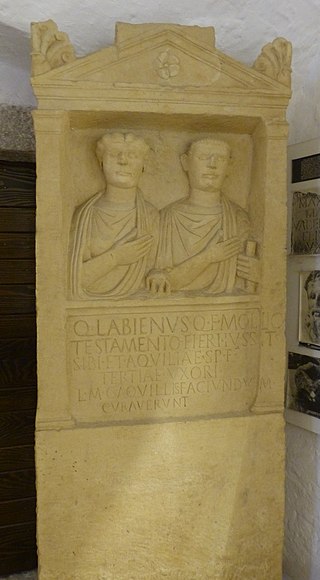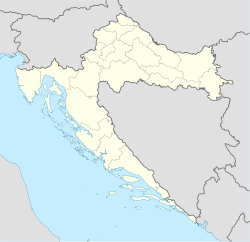
Poreč is a town and municipality on the western coast of the Istrian peninsula, in Istria County, west Croatia. Its major landmark is the 6th-century Euphrasian Basilica, which was designated a UNESCO World Heritage Site in 1997.

Pazin is a town in western Croatia, the administrative seat of Istria County. It is known for the medieval Pazin Castle, the former residence of the Istrian margraves.

Buje is a town situated in Istria, Croatia's westernmost peninsula.

Nin is a town in the Zadar County of Croatia.

Novigrad is a town in Istria County in western Croatia. It is also sometimes referred to as Novigrad Istarski to distinguish it from three other Croatian towns of the same name.

Žminj is a municipality and small town in Istria, Croatia, 15 km south of Pazin.

Barban is a small town and municipality in the southern part of eastern Istria, Croatia.

Vodnjan is a town in Istria County, Croatia, located about 10 kilometers north of the largest city in Istria, Pula-Pola.

Cerovlje is a village and a municipality in Istria, Croatia.

Gračišće is a village and municipality of Istria County in Croatia.

Kršan is a village and municipality in the eastern part of Istria County, Croatia.

Oprtalj is a village and municipality in Istria, Croatia. Oprtalj is a community in the central northern part of Istria County, situated across the Mirna river valley from the village of Motovun, about 20 km northwest of Pazin.

Svetvinčenat is a village and municipality in the south of the central part of Istria, Croatia, about 25 km southwest of Pazin and 25 km northeast of Pula.

Brod Moravice is a municipality in the Primorje-Gorski Kotar County in western Croatia.
Baredine is a village in Istria County in Croatia. Administratively it belongs to Buzet.

Žejane is a village in the eastern part of the mountainous Ćićarija area in Istria, in western Croatia. Administratively it belongs to the municipality of Matulji in Primorje-Gorski Kotar County. In 2011, the population of Žejane was 130.

Paz is a village and ruined castle in Istria County, Croatia, in the municipality of Cerovlje. In 2011, the population of the village is 72.
The Roman Catholic Diocese of Pedena was a Catholic diocese located in the town of Pedena in the central part of Istria, Croatia, 12 km southeast of Pazin. Pedena is now the name of a Latin titular see.

Gologorica, historically known as Moncalvo di Pisino, is a village in central Istria, near Pazin (Pisino).

Beram is a small village located in the Croatian county of Istria. It is part of the municipality of Pazin and is situated approximately five kilometres (3.1 mi) northwest of the town, on the road to Poreč. The village has a population of about 250 inhabitants. It is well-known for its Biblia pauperum and the Danse Macabre fresco in the Church of Maria im Fels.























